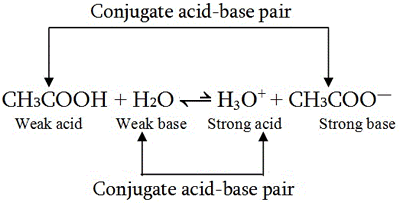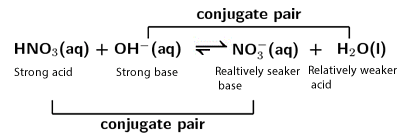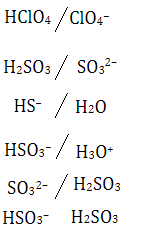Conjugate acids/bases.
In the Brønsted–Lowry definition of acids and bases, a conjugate acid–base pair consists of two substances that differ only by one proton (H⁺).
A conjugate acid is formed when a base accepts a proton while a conjugate base is formed when an acid donates a proton
Every acid/base reaction consists of two conjugate acid/base pairs as shown on the right.

A strong acid will have a relatively weaker conjugate base while a weak acid will have a relatively stronger conjugate base. A weak base will have a strong conjugate acid while a strong base will produce a weak conjugate acid.
The acid base conjugate pairs for the reaction between nitric acid and hydroxide ion are:
- HNO3 / NO3- and OH- / H2O
Notice how the species of each conjugate
pair differ by just one
proton (H⁺).
The arrows indicate that the reaction will proceed to the right to a significant extent, as all strong acids and bases tend to do.

1. Ammonia is a weak base and reacts with water according to the incomplete equation shown on the right.
Label:
- the two conjugate acid / base pairs
- the relative strength of each species
- indicate with arrows if this reaction will proceed in the forward direction to a significant degree.
Solution

2. Sulfuric acid reacts in an acid base reaction with water with the transfer of one proton . Sulfuric acid, being a strong acid, the reaction proceeds in the forward direction until all the acid is used up. Write a balanced equation and indentify the conjugate pairs.
Solution

3. Consider the species paired shown on the right. Circle the conjugate pairs and indicate the acid and base.
Solution
